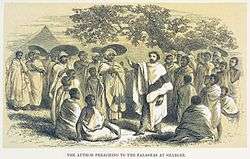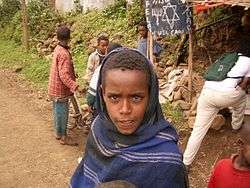Falash Mura
Falash Mura is the name given to those of the Beta Israel community in Ethiopia and Eritrea who converted to Christianity under pressure from the mission during the 19th and 20th centuries. This term consists of Jews who did not adhere to Jewish law, as well as Jewish converts to Christianity, who did so either voluntarily or who were forced to do so.
There are approximately 8,200 Falash Mura living in Ethiopia today. The Israeli government, in 2018, approved a plan to allow 1,000 of them to move to Israel.


Terminology
The original term that the Beta Israel gave to the converts was "Faras Muqra" ("horse of the raven") in which the word "horse" refers to the converts and the word "raven" refers to the missionary Martin Flad who used to wear black clothes.[1] This term derived the additional names Falas Muqra, Faras Mura and Falas Mura. In Hebrew the term "Falash Mura" (or "Falashmura") is probably a result of confusion over the use of the term "Faras Muqra" and its derivatives and on the basis of false cognate it was given the Hebrew meaning Falashim Mumarim ("Converted Falashas").
History
In 1860 Henry Aaron Stern, a Jewish convert to Christianity, traveled to Ethiopia and Eritrea in an attempt to convert the Beta Israel community to Christianity. The Christian missionaries had more success with the population of Eritrea, while Eritrea is also known for a Solomon Jewish dynasty. Henry Aaron Stern could convert the people of Eritrea easily because the communication and infrastructure of colonial settlers were easier there than in Ethiopia.
In the Achefer woreda of the Mirab Gojjam Zone, roughly 1,000-2,000 families of Beta Israel were found. There may be other such regions in Ethiopia with significant Jewish enclaves, which would raise the total Jewish population to more than 50,000 people.
Groups
- Faras Muqra [1]
- Maryam Wodet (The Lovers of Mary)[1]
- Shamane [1]
- Muslims[1]
- Beta Abraham[1]
- Eritrean people[1]
Aliyah
On February 16, 2003, the Israeli government applied Resolution 2958 to the Falash Mura, which grants maternal descendants of Jews the right to immigrate to Israel under the Israeli Law of Return and to obtain citizenship if they convert to Judaism.[2]
References
- 1 2 3 4 5 6 7 Abbink, Gerrit Jan (1984). The Falashas in Ethiopia and Israel: the problem of ethnic assimilation. Institute for Cultural and Social Anthropology. pp. 81–82.
- ↑ "Falashmura aliyah - follow-up report" (PDF) (in Hebrew). Israeli Association for Ethiopian Jews. Archived from the original (PDF) on March 5, 2009.
Further reading
- Samuel Gobat, Journal of a three years' residence in Abyssinia: in furtherance of the objects of the Church Missionary Society, Hatchard & Son; and Seeley & Sons, 1834
- Henry Aaron Stern, Wanderings among the Falashas in Abyssinia: Together with Descriptions of the Country and Its Various Inhabitants, Wertheim, Macintosh, and Hunt, 1862
- Johann Martin Flad, The Falashas (Jews) of Abyssinia, W. Macintosh, 1869
- Eric Payne, Ethiopian Jews: the story of a mission, Olive Press, 1972
- Steven Kaplan, "The Beta Israel (Falasha) Encounter with Protestant Missionaries: 1860-1905", Jewish Social Studies 49 (1), 1987, pp. 27–42
- Michael Corinaldi, Jewish identity: the case of Ethiopian Jewry, Magnes Press, 1998, ISBN 9652239933
- Daniel Frieilmann, "The Case of the Falas Mura" in Tudor Parfitt & Emanuela Trevisan Semi (Editors), The Beta Israel in Ethiopia and Israel: Studies on Ethiopian Jews, Routledge, 1999, ISBN 9780700710928
- Don Seeman, "The Question of Kinship: Bodies and Narratives in the Beta Israel-European Encounter (1860-1920)", Journal of Religion in Africa, Vol. 30, Fasc. 1 (Feb., 2000), pp. 86–120
- Emanuela Trevisan Semi, "The Conversion of the Beta Israel in Ethiopia: A Reversible "Rite of Passage"", Journal of Modern Jewish Studies 1 (1), 2002, pp. 90–103
- Don Seeman, One People, One Blood: Ethiopian-Israelis and the Return to Judaism, Rutgers University Press, 2010, ISBN 9780813549361
